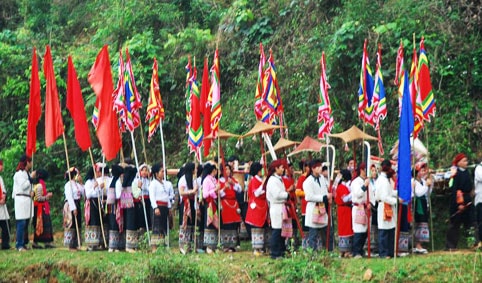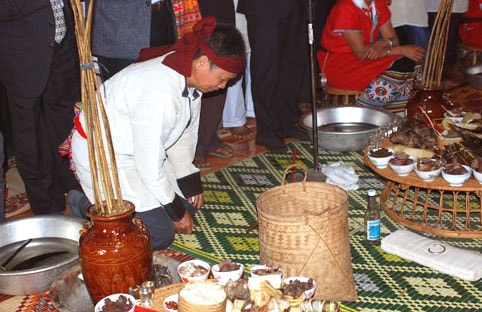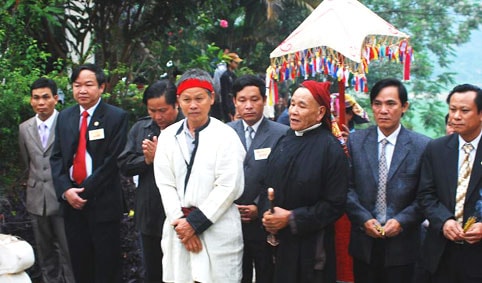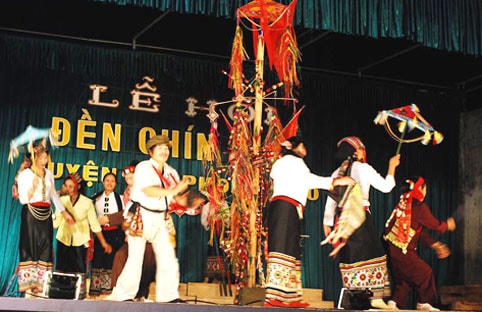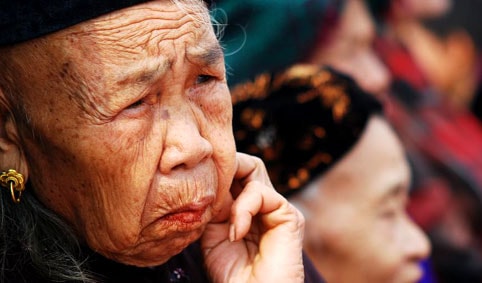Sacred Nine-Room Temple Festival
(Baonghean) –This morning, March 29, 2010, the Nine-Room Temple Festival opened in Que Phong district..The Festival takes place over 3 days, from March 29 to 31.
Nine-Room Temple FestivalA unique big festival of the Thai people in Western Nghe An. The ceremony is solemn and sacred, the festival is bustling and joyful, full of national culture. The procession follows each other, winding through the villages, through the streams, all heading towards the Temple, so that boys and girls can compete, perform love songs, so that the gong sounds can resound, spread to the villages, echo to the mountains and forests when turning to a new day….
|
Dating back to the 14th century, the Nine-Garden Temple is a sacred gathering place for the Thai people throughout the three districts along Highway 48: Quy Chau, Quy Hop, Que Phong, because the nine large ancient Muongs of Phu Quy in the past all considered this as their ancestral land: Muong Ton, where the Thai people built their land and established Muongs in the vast legendary times. This place worships the King of Heaven - praying for favorable weather and wind, worships Tao Lo Y - the one who had the merit of building the land and opening Muongs. Having gone through many ups and downs, the Nine-Garden Temple of the past seems to have become a legend, but its sacred mark still remains forever in the hearts of every citizen of Phu Quy.
Back to the legend
In the treasure trove of Thai folk tales, there is still a beautiful legend of the founding of the Muong.
Under the talented and virtuous rule of Tao Lo Y, life in the past was much different. But God still often caused natural disasters and floods, so the people of the Muongs asked Tao to build a temple in Muong Ton, as a place to offer buffaloes to God, praying for favorable weather and crops. The local people called the temple Ten Xo Quai (Cow Offering Temple), but because the temple had nine rooms, it was changed to Ten Cau Hong (Nine-Room Temple).
|
Sparkling festival
Usually, during each festival, the indispensable offering is a buffalo that has never been used for plowing and has no defects on its body. In addition, each village has 9 piglets, 90 small chickens and 90 grilled river fish. Nowadays, to be suitable, it is not necessary to have all the offerings as before, but still ensure all the details, even the smallest, to serve in the festival.
On the opening day of the festival, the Tao Muong gathered the elders, officials and young men of the nine Muongs to bring offerings, including fish, chickens, pigs, wine and buffaloes. The procession was led by the Tao Muong, followed by the elders, officials, offerings, followed by Ong Ap (the man bathing the buffalo), Ba Mo Muong, Cac Xao Luc Mo (beautiful girls) and finally the group of people attending the festival of the Muong. The group followed each other, winding through the villages, through the ravines, through the streams, all heading towards the temple. Upon arrival, the Muongs divided up and brought the offerings to the room reserved for their own Muong, where there were already 9 bamboo trays, 9 reed stalls, 3 wooden trays (Muong Ton alone had 5 wooden trays). The stalls were arranged in 4 levels. In the middle of each room was a jar of wine with 9 bamboo sticks.
At the "Hap Quai" ceremony (buffalo offering ceremony), the shaman leads the Tao Muong, the Ap and the elders holding torches to circle the buffalo of the Muong 3 times to show their agreement to offer the buffalo. Then the Ap leads
The solemn and sacred ceremony ended, starting the bustling and joyful activities of the festival: crossbow shooting, tug of war, traditional wrestling, bamboo dancing, hoop dancing, con throwing, the camp also attracted a large number of boys and girls to participate. But the most noticeable were still the love songs performed in the forms of xuoi, lam, nhuon. These songs, in addition to wishing the village to live long, wishing the 9 villages and 10 villages peace and happiness, were also love songs, looking for friends. This activity was not only around the temple area but also spread to neighboring villages and lasted until the mountains and forests turned to a new day. The words "hap bao thao" (boys and girls singing love songs) were very simple but extremely lyrical:The monster Pu Quai is growing / The monster Muong Noc is melting(I wish I could catch the dew at Trau Temple so the reeds can catch the wind / I wish I could be the wife or husband of a Muong Noc woman who is famous for her beauty in all nine Muongs).
|
Those songs seemed to spread throughout the nine villages and ten muongs, bringing Muong Chun and Muong Quang closer together, making Muong Chon and Muong Chong more beautiful, so that at the Nine-Room Temple Festival we could meet again, so that the Thai people could rejoice with other ethnic groups in all parts of the country.
Article and photos: Tran Hai

